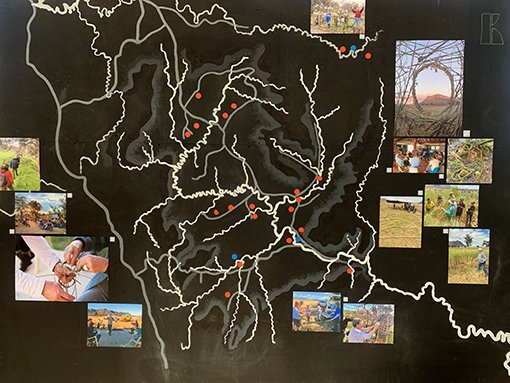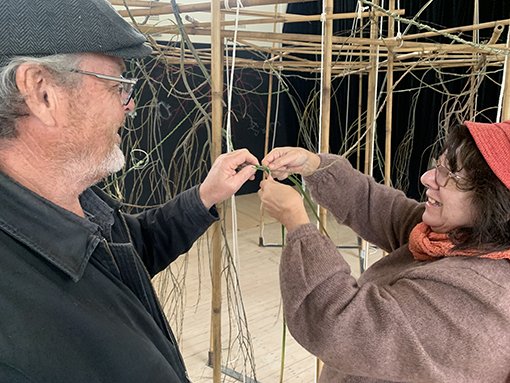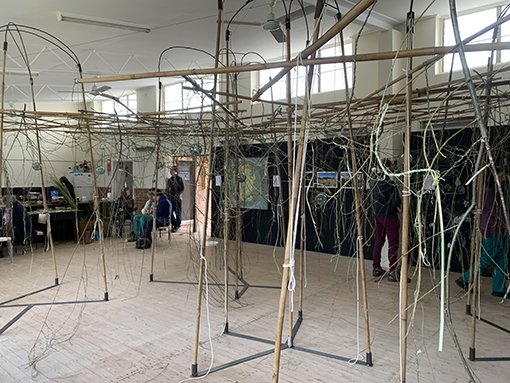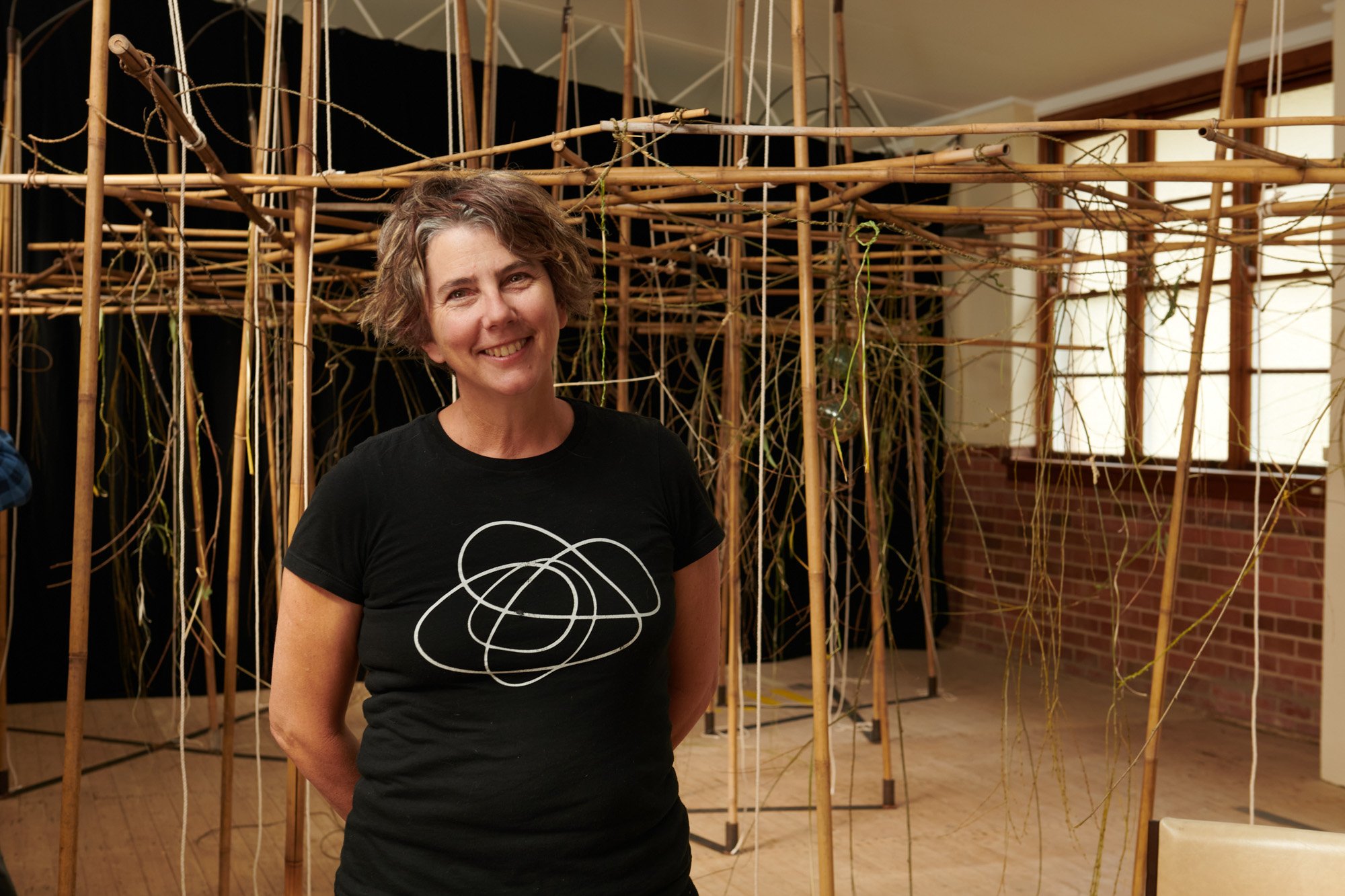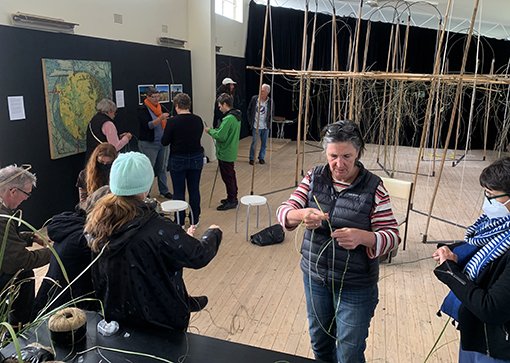On a stunning weekend in May 2022, the Cementa Festival took place in Kandos. Among the installations were two by KSCA members Georgie Pollard and Leanne Thompson. These works represented the final stages of The Capertee Hydrology Project. They included maps, photos, videos and a participatory installation made of woven grass string and bamboo that Cementa visitors contributed to throughout the weekend. Both artists wrote thoughtful texts to accompany their works which we’ve printed them below.
These videos tell the story of the many phases of this Project:
Georgie Pollard: ‘Map of the Capertee Valley’
In association with KSCA, Capertee Valley Landcare and Cementa
These two maps represent the beginning and the end of the hydrology project in the Capertee Valley.
The chalk board map was produced at the beginning of the project to serve as a catalyst for discussions around living in the Valley. How did the residents/landholders understand their relationship to water as it flows and through the valley and out to the Colo River. It stayed in the hall throughout the project, participating in dinners, afternoon teas, weaving workshops, weed tours and an introductory talk by Peter Swain on taking care of the land from an Aboriginal perspective as well as Stuart Andrews on Natural Sequence Farming.
The collage map was produced by the end of the project and serves as a mnemonic device to the project, reminding us not only of the different elements that made up the project such as weaving, contours, weeds and NSF, but also of colonisation and who we are in relationship to the landscape. This map is a writing on the landscape. We write on the landscape all the time, be it through legislation, mapping, agricultural practices as well as storytelling. All maps write on the landscape, imposing what we know or what we think we know on the land, affecting our relationship to it.
Maps also don’t generally include time unless you look for, or can read the symbolic markers. As a geometric abstraction in space, a map will leave out the aspect of time and the uncertainty that it brings in order to make a comprehensible and useful document. This map participates in time by being highly specific to it. This map is to be comprehended by participants in the project of a particular time and place. The image of this map also includes narrative, a sequence of events in the landscape and the pace of its construction. It is hoped that this map will be buried in time, its original intentions mired in the swamp of events as time flows. I’m hoping that in time this map becomes incomprehensible.
Leanne Thompson: Capertee Weaving Water
Capertee Weaving Water was the creative arts engagement that accompanied the Capertee Hydrology and Resilient Farmers projects over a year during 2019-20. The project explored intersections between farming practices, landscape hydrology, water resource strategies, land conservation, sustainable ecosystems, well-being and community resilience during drought, bushfires and virus.
We facilitated creative community engagement with specialist knowledge workshops (science, regenerative agriculture, mental health) while empowering individuals to tangibly encounter materials in the landscape. The entire valley community was invited to participate, weaving circles and symbolically binding them together to form the final sculpture and to join in the water ceremony.
There were five key artists involved, generating engagement and sharing knowledge with the valley community; Georgie Pollard, Peter Swain, Lanny Mackenzie, Peter Williamson and Leanne Thompson as lead artist. Alex Wisser managed creative co-ordination and photography and Justin Hewitson created the accompanying videos. The project also overlapped with the pilot Land Studio Camp conceived and delivered by Laura Fisher with Lucas Ihein and art students from Wollongong University.
Alongside Capertee Valley Landcare and KSCA (Georgie, Leanne, Alex, Laura and Lucas are all members), the other collaborators in this project were Cementa, Wentworth Healthcare, Lithgow Council, the Rural Adversity Mental Health Program, the Rural Arts Fund, the Mulloon Institute, Tarwyn Park Training, and many volunteers from the valley community.
Leanne Thompson: Permeare
Weaving is a great activity to create functional and beautiful objects fashioned from the natural materials growing around us. In the process, it also enables conversations, stories, and insights to be woven together.
Please join in this ‘growing’ conversation about living soil, wetlands and water. There are no boundaries in this world, everything we perceive as discrete entities are held apart by permeable membranes; where everything is mobile, sharing, communicating.


